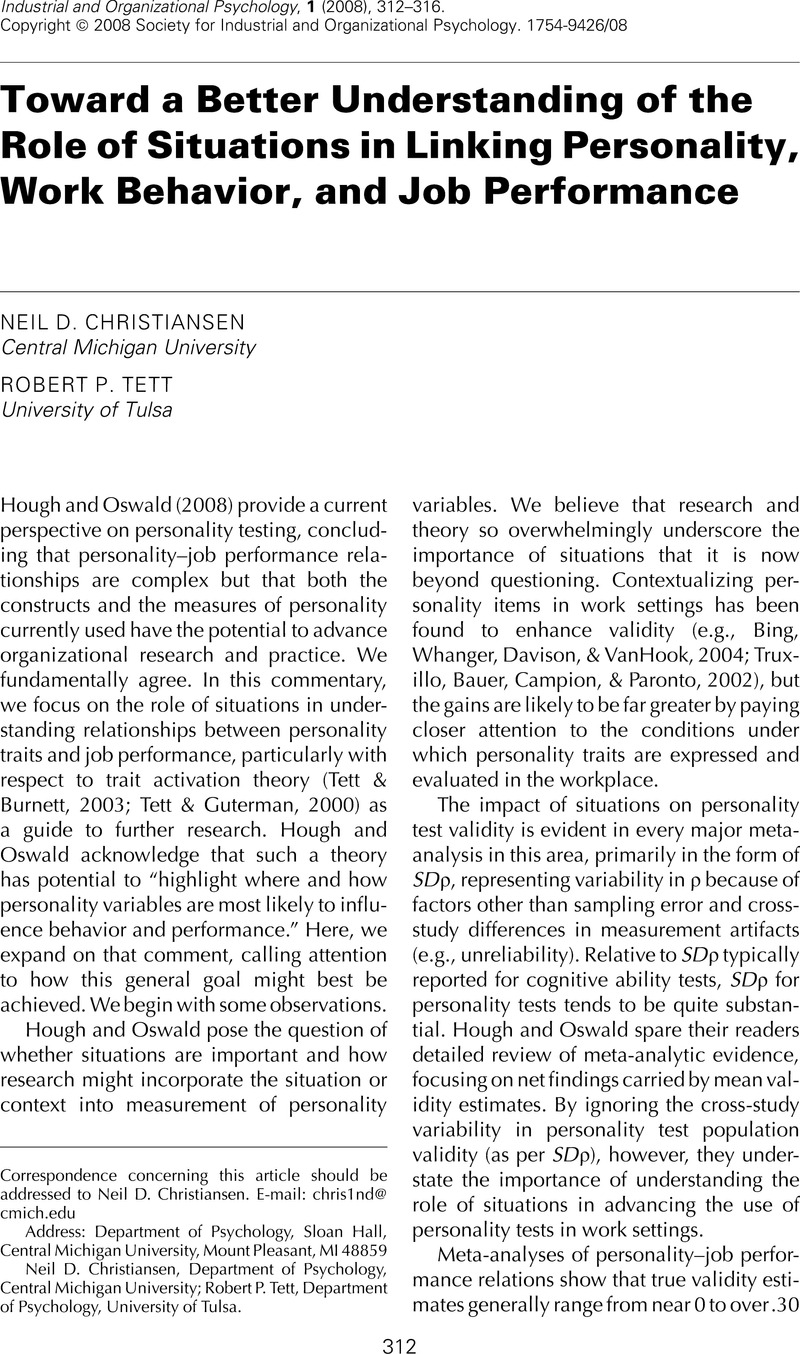Crossref Citations
This article has been cited by the following publications. This list is generated based on data provided by Crossref.
Oswald, Frederick L.
and
Hough, Leaetta M.
2008.
Personality Testing and Industrial–Organizational Psychology: A Productive Exchange and Some Future Directions.
Industrial and Organizational Psychology,
Vol. 1,
Issue. 3,
p.
323.
Burns, Gary N.
and
Christiansen, Neil D.
2011.
Self‐efficacy in the Workplace: Linking personality to domain‐specific efficacy beliefs.
International Journal of Selection and Assessment,
Vol. 19,
Issue. 4,
p.
429.
Susing, Ingo
and
Cavanagh, Michael J
2013.
At the intersection of performance: Personality and adult development in coaching.
International Coaching Psychology Review,
Vol. 8,
Issue. 2,
p.
58.
Bing, Mark N.
Davison, H. Kristl
and
Smothers, Jack
2014.
Item‐level Frame‐of‐reference Effects in Personality Testing: An investigation of incremental validity in an organizational setting.
International Journal of Selection and Assessment,
Vol. 22,
Issue. 2,
p.
165.
Christiansen, Neil D.
Quirk, Stuart W.
Robie, Chet
and
Oswald, Frederick L.
2014.
Light Already Defines the Darkness: Understanding Normal and Maladaptive Personality in the Workplace.
Industrial and Organizational Psychology,
Vol. 7,
Issue. 1,
p.
138.
Fullarton, Christie
Fuller-Tyszkiewicz, Matthew
and
von Treuer, Kathryn
2014.
The mediating role of work climate perceptions in the relationship between personality and performance.
European Journal of Work and Organizational Psychology,
Vol. 23,
Issue. 4,
p.
525.
Lin, Naiqing
Jang, Jichul
and
Roberts, Kevin R.
2018.
Are employees with higher organization-based self-esteem less likely to quit? A moderated mediation model.
International Journal of Hospitality Management,
Vol. 73,
Issue. ,
p.
116.
Barelds, Dick P. H.
Wisse, Barbara
Sanders, Stacey
and
Laurijssen, L. Maxim
2018.
No Regard for Those Who Need It: The Moderating Role of Follower Self-Esteem in the Relationship Between Leader Psychopathy and Leader Self-Serving Behavior.
Frontiers in Psychology,
Vol. 9,
Issue. ,
de Jong, Nicole
Wisse, Barbara
Heesink, José A. M.
and
van der Zee, Karen I.
2019.
Personality Traits and Career Role Enactment: Career Role Preferences as a Mediator.
Frontiers in Psychology,
Vol. 10,
Issue. ,
Schyns, Birgit
Wisse, Barbara
and
Sanders, Stacey
2019.
Shady Strategic Behavior: Recognizing Strategic Followership of Dark Triad Followers.
Academy of Management Perspectives,
Vol. 33,
Issue. 2,
p.
234.
Ocampo, Anna Carmella G.
Wang, Lu
Kiazad, Kohyar
Restubog, Simon Lloyd D.
and
Ashkanasy, Neal M.
2020.
The relentless pursuit of perfectionism: A review of perfectionism in the workplace and an agenda for future research.
Journal of Organizational Behavior,
Vol. 41,
Issue. 2,
p.
144.
Hein, Rüdiger
2021.
Typisch Social Entrepreneurship.
p.
175.
Schyns, Birgit
Gauglitz, Iris K.
Gilmore, Sarah
and
Nieberle, Karolina
2023.
Vulnerable narcissistic leadership meets Covid-19: the relationship between vulnerable narcissistic leader behaviour and subsequent follower irritation.
European Journal of Work and Organizational Psychology,
Vol. 32,
Issue. 6,
p.
816.
Pryor, Hannah N.
2024.
The mindset of recordkeeping: the intersection of records management and organizational psychology.
Records Management Journal,
Vol. 34,
Issue. 1,
p.
29.
Laurijssen, L. Maxim
Wisse, Barbara
Sanders, Stacey
and
Sleebos, Ed
2024.
How to Neutralize Primary Psychopathic Leaders’ Damaging Impact: Rules, Sanctions, and Transparency.
Journal of Business Ethics,
Vol. 189,
Issue. 2,
p.
365.





